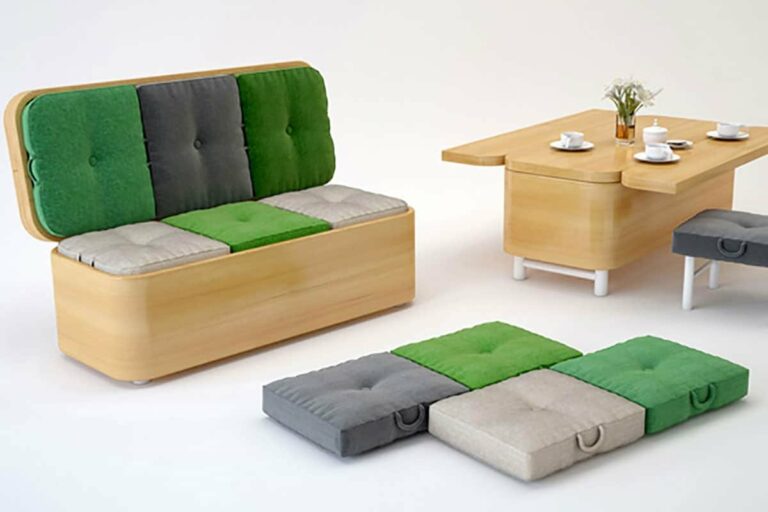Tips For Choosing Pest-Resistant, Eco-Friendly Furniture
Looking for eco-friendly furniture that can resist pests and insects? We’ve got you covered. Discovering the perfect furniture for your space can be a daunting task, especially when you want it to be environmentally friendly and durable against unwanted critters. But worry not, because in this blog post, we will guide you through the process of choosing eco-friendly furniture that is resistant to pests and insects. Whether you’re a nature enthusiast or simply want to create a healthier home, we have all the tips and tricks you need. So let’s dive right in!
How to Choose Eco-Friendly Furniture That Is Resistant to Pests and Insects?
Choosing furniture that is not only eco-friendly but also resistant to pests and insects is essential for creating a healthy and sustainable living environment. In this comprehensive guide, we will delve into the various factors you need to consider when selecting eco-friendly furniture that can withstand pest infestations. From materials and finishes to construction techniques and maintenance, we will cover it all. So, let’s get started and explore how you can make informed choices when it comes to eco-friendly pest-resistant furniture.
Section 1: Understanding the Importance of Eco-Friendly Furniture
Before we dive into the details of choosing eco-friendly furniture that is resistant to pests and insects, let’s take a moment to understand its significance. Eco-friendly furniture not only minimizes our impact on the environment but also promotes sustainable production practices. By opting for eco-friendly materials and finishes, we reduce the use of harmful chemicals and contribute to a healthier indoor environment. Additionally, choosing furniture that resists pests and insects ensures longevity and prevents the need for harmful pesticides. Now, let’s move on to the key factors to consider when selecting such furniture.
Section 2: Selecting the Right Materials
When it comes to choosing eco-friendly furniture that is resistant to pests and insects, the selection of materials plays a crucial role. Here are some materials to consider:
1. Hardwoods
- Opt for sustainably sourced hardwoods such as oak, maple, or teak.
- Ensure the wood is certified by organizations like the Forest Stewardship Council (FSC) to guarantee responsible harvesting practices.
- Choose hardwoods with natural insect-repellent properties like cedar or eucalyptus.
2. Bamboo
- Consider furniture made from bamboo, a fast-growing renewable resource.
- Check if the bamboo is treated with natural insect repellents during manufacturing.
3. Recycled Materials
- Look for furniture made from recycled materials like reclaimed wood or recycled plastic.
- Ensure that the recycled materials are properly treated to resist pests and insects.
Section 3: Finishes and Coatings
Choosing the right finishes and coatings for your eco-friendly furniture is essential for both aesthetics and pest resistance. Here are a few options to consider:
1. Natural Oils and Waxes
- Opt for furniture finished with natural oils like linseed or tung oil.
- Consider wax coatings for an added layer of protection.
2. Water-Based Finishes
- Choose water-based finishes instead of traditional solvent-based ones.
- Ensure the finishes are low in volatile organic compounds (VOCs) for a healthier indoor environment.
3. Powder Coatings
- Consider furniture with powder-coated finishes for increased durability.
- Ensure the powder coating is free from harmful substances like lead or mercury.
Section 4: Construction Techniques
Apart from materials and finishes, paying attention to the construction techniques used in eco-friendly furniture is vital. Here are a few considerations:
1. Solid Construction
- Choose furniture with sturdy joints and solid construction for durability.
- Avoid furniture with excessive use of adhesives or harmful chemicals in the manufacturing process.
2. Natural Joinery
- Look for furniture that uses traditional joinery techniques like dovetail or mortise and tenon joints.
- Avoid furniture with excessive use of metal brackets or screws.
3. Minimal Use of Glue
- Opt for furniture that minimizes the use of glue or adhesives.
- Ensure any adhesive used is eco-friendly and non-toxic.
Section 5: Maintenance and Care
Proper maintenance and care are key to ensuring that your eco-friendly furniture remains resistant to pests and insects. Here are some tips to keep in mind:
1. Regular Cleaning
- Regularly clean your furniture to remove dust and debris that can attract pests.
- Use non-toxic cleaning solutions to avoid chemical residue.
2. Protective Covers
- Consider using protective covers when the furniture is not in use.
- Ensure the covers are made from eco-friendly materials.
3. Natural Pest Deterrents
- Explore natural pest deterrents like essential oils or herbal sachets to repel insects.
- Ensure the pest deterrents you use are safe for both your furniture and the environment.
Section 6: Eco-Friendly Pest Control
Despite taking preventive measures, it is possible for pests and insects to find their way into your furniture. In such cases, it’s important to opt for eco-friendly pest control methods. Here are a few options:
1. Diatomaceous Earth
- Consider using diatomaceous earth, a natural powder made from fossilized algae, to eliminate pests.
- Follow the instructions carefully and use it sparingly to avoid any adverse effects.
2. Neem Oil
- Neem oil, derived from the neem tree, is an effective and eco-friendly pest control option.
- Use it as directed to eliminate pests without harming the environment.
3. Beneficial Insects
- Introduce beneficial insects like ladybugs or nematodes to your outdoor furniture area.
- These insects can help control pest populations naturally.
Section 7: Evaluating Eco-Certifications
When purchasing eco-friendly furniture, it’s important to look for certifications that validate the sustainability and pest resistance of the products. Here are a few renowned eco-certifications to consider:
1. Forest Stewardship Council (FSC)
- Look for FSC-certified furniture to ensure responsible sourcing of wood materials.
- FSC certification guarantees sustainable production practices.
2. GreenGuard
- GreenGuard certification ensures that furniture meets strict emissions standards for improved indoor air quality.
- Consider furniture with this certification for a healthier living environment.
3. Cradle to Cradle (C2C)
- Furniture carrying the C2C certification signifies its environmental sustainability throughout its lifecycle.
- It takes into account factors like materials, manufacturing, and end-of-life disposal.
Section 8: Budget Considerations
While eco-friendly and pest-resistant furniture may come with a higher price tag, it is important to consider the long-term benefits. Investing in quality, sustainable furniture can save you money in the long run by reducing the need for replacements or pest control treatments. It also contributes to a healthier environment and supports responsible manufacturing practices. Therefore, consider your budget holistically and prioritize sustainable options whenever possible.
Section 9: Seeking Expert Advice
If you are unsure about selecting the right eco-friendly furniture that is resistant to pests and insects, don’t hesitate to seek advice from professionals. Local furniture stores or interior designers specializing in sustainable design can provide valuable insights and help you make informed decisions based on your specific needs and preferences.
Section 10: Conclusion
In conclusion, selecting eco-friendly furniture that is resistant to pests and insects is a wise choice for a healthy and sustainable living space. By considering factors like materials, finishes, construction techniques, maintenance, and eco-certifications, you can make informed choices that promote both your well-being and the environment. Always remember to prioritize quality and longevity when selecting furniture, as it plays a significant role in reducing waste and protecting our planet. So go ahead and furnish your space with eco-friendly, pest-resistant furniture, and enjoy a harmonious blend of style, functionality, and sustainability.
New Furniture, Stink Bugs Infestation, How I Deal With Pests Without Using Pesticides
Frequently Asked Questions
What are some eco-friendly materials used in pest and insect-resistant furniture?
Some eco-friendly materials commonly used in pest and insect-resistant furniture include cedar, bamboo, reclaimed wood, and natural oils like neem oil. These materials naturally repel pests and insects, making them a great choice for environmentally-conscious furniture options.
How can I ensure that the furniture I choose is resistant to pests and insects?
When choosing eco-friendly furniture, look for those that are specifically treated or made with pest and insect-resistant materials. Check product labels or descriptions for information on whether the furniture has undergone any pest or insect repellent treatments.
Are there any specific certifications or labels to look for when choosing eco-friendly furniture with pest and insect resistance?
Yes, one certification to look for is the FSC (Forest Stewardship Council) label, which ensures that the wood used in the furniture is sustainably sourced. Additionally, some furniture may have certifications indicating that it has been treated with eco-friendly pest and insect repellents.
What additional features should I consider when selecting eco-friendly furniture that is resistant to pests and insects?
Consider furniture with tight joints and sealed gaps, as these features help prevent pests and insects from finding hiding places or entry points. It is also beneficial to choose furniture with natural finishes or non-toxic coatings that do not attract pests.
Can I use natural remedies to make my existing furniture more resistant to pests and insects?
Absolutely! There are several natural remedies you can try, such as using essential oils like tea tree oil, lavender oil, or citronella oil, which are known to repel pests. Sanding and refinishing wooden furniture with natural oils like neem oil can also help increase its resistance to pests and insects.
Are there any disadvantages to choosing eco-friendly furniture that is resistant to pests and insects?
While eco-friendly furniture with pest and insect resistance has numerous benefits, it is important to note that it may cost slightly more than conventional furniture due to the use of specific materials and manufacturing processes. However, the long-term advantages in terms of durability, health benefits, and sustainability outweigh this potential drawback.
Final Thoughts
To choose eco-friendly furniture that is resistant to pests and insects, it is crucial to consider certain factors. First, opt for furniture made from sustainable materials such as bamboo or reclaimed wood, which naturally repel pests. Secondly, look for furniture treated with non-toxic, eco-friendly finishes that deter insects. Additionally, consider furniture designs that minimize hiding places for pests, such as avoiding intricate carvings or gaps. Regular maintenance and cleaning are essential in preventing infestations. By following these guidelines, you can ensure that the eco-friendly furniture you choose remains resilient against pests and insects while promoting a healthier and sustainable living environment. How to choose eco-friendly furniture that is resistant to pests and insects?





